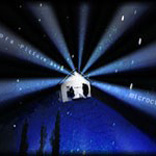No longer mere housewifery, sewing is the work of smart, cutting-edge artists. Stitching, knitting, embroidering, crocheting, weaving, suturing: these are the acts of those who make the powerfully splayed, the uncannily flaccid and the lovely weird. Lily Hanson is one of these makers — a member of a rising group of artists with a shared interest in textile art.
Along with Saskia Jordá, Vanessa Cash, Jason Villegas, Jeff Hand, Amy Revier and Frances Bagley, Hanson fashions formless objects that are beautifully formal. She makes no bones about it, in the most literal sense of the words. Her stuff is abstract while cute, invertebrate though by no means spineless. In short, Hanson's work is forthright in its inventive oddity.
Dallas-based and ready to go, Hanson transforms collages made from W, a visual fête for the fashionista, into microbiological studies of the absurd. An advertisement for a high-end handbag becomes the basis for a bladder-like form that will soon hang droopily from her wall. Her work may be decidedly informal, both blobby and amorphous, but her process is tight and precise. Hanson is a very clean artist. She is an inveterate caretaker of form, having worked prudently with her hands since she was a child. As a youngster, Hanson was a baker who made tiny cookies and cupcakes bedecked with candy ornaments. One imagines colorful edible mounds not unlike the shapely pillow-like varmints carefully tucked away in the storage of her studio space.
Like her collages, Hanson's working drawings are immaculate. The translation of a meticulous re-rendering of an IKEA diagram of a toilet into the alien-corporeal fabric objects that are truly Hanson's forte no doubt piques interest. It is also revealing of her talents. Stuffed and hanging on the wall, She Came A Long Way for Nothing and Overflow oddly, even counter-intuitively, began in concept with Hanson's redrawing of technocratic how-to directions. You know the type: the framed drawings of a woman inserting a tampon or two people putting together an étagère that likely would require three sets of hands. That she derives sometimes organic, always otherworldly form from a bureaucracy of information is telling of her science. Hanson is a doctor of what I'd like to call the 'soft uncanny.'
The soft uncanny — or the snuggly strange — may be loosely included under the recently codified nomenclature of what the French surrealist-cum-communist Georges Bataille called the 'formless' (informe ). Opposite the heavenly and transcendent, the formless is earthly and material. As Bataille put it, "What it designates has no rights in any sense and gets itself squashed everywhere, like a spider or an earthworm." [1] The formless entered the realm of the officially sanctioned in 1996 when it became the title of a new anti-canon. The catalogue Formless: A User's Guide was written by two members of the October mafioso, Rosalind Krauss and Yves-Alain Bois, for an exhibition held at the Centre Pompidou in Paris. In an act of productive plagiarizing, the silverbacks of the art history world and éminences grises of Artforum thus created a new category for art after painting and Clement Greenberg. In contrast to the official modernism of Greenberg, Krauss and Bois put forth the 'formless,' characterized by four primary qualities: base materialism, horizontality, pulse and entropy. Money in the bank for seminal academic peddlers, the formless provides a helpful armature for everything that has been made after WWII, including the products of a new bevy of fabricators working in fabric.
A graduate of SMU's MFA program and Hampshire College in Amherst, Massachusetts, Hanson cites Richard Tuttle and Jodie Lee, an SMU graduate and former SMU professor, as influences. The odds-and-ends quality of Tuttle and Lee's work is clearly present in Hanson's burgeoning oeuvre. While working at the Dallas Museum of Art, Hanson absconded with several wire installation mounts that had been cast aside for the trash. They became her Mounts, blue felt-covered metal fingers protruding from the wall. Detritus gave way to line- and shadow-makers with soft, sky-colored carapaces. Though her work clearly resonates with that of Tuttle and Lee, the great power of Hanson's making is that it is truly all her own. The nude-pantyhose-colored Adjoin is a testament to her singular imagination. It reads like a generous extraplanetary limb, perhaps a digit or a leg. The joints are articulated with the aplomb of Dr. Zoidberg from the TV cartoon 'Futurama.'
Hanson has recently achieved a level of maturity in her work. The combination of resolution and provocation in her pieces gives her the kind of readiness that sends an artist off to one of the coasts, New York City or LA. We are lucky to have her here. But Hanson's star is rising and will likely soon surpass the microgalaxy of Texas to cast its light on worlds beyond.
1. Bataille, Georges, Visions of Excess: Selected Writings, 1927-1939, ed. Allan Stoekl, (Minneapolis: University of Minnesota Press, 1985) 31.
Images courtesy the artist.
Charissa N. Terranova is an Associate Proffessor at SMU and a Contributing Editor to Glasstire.






